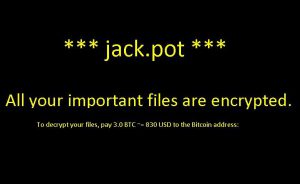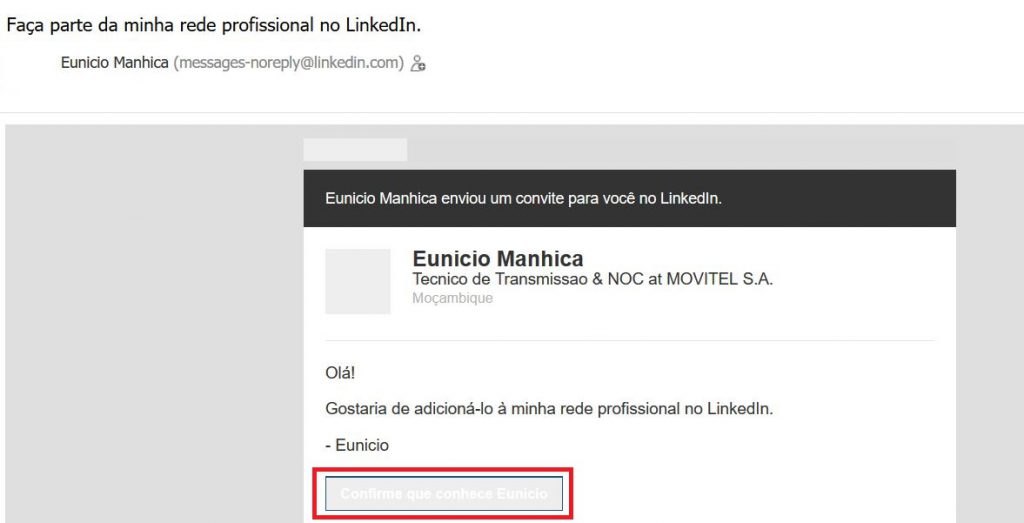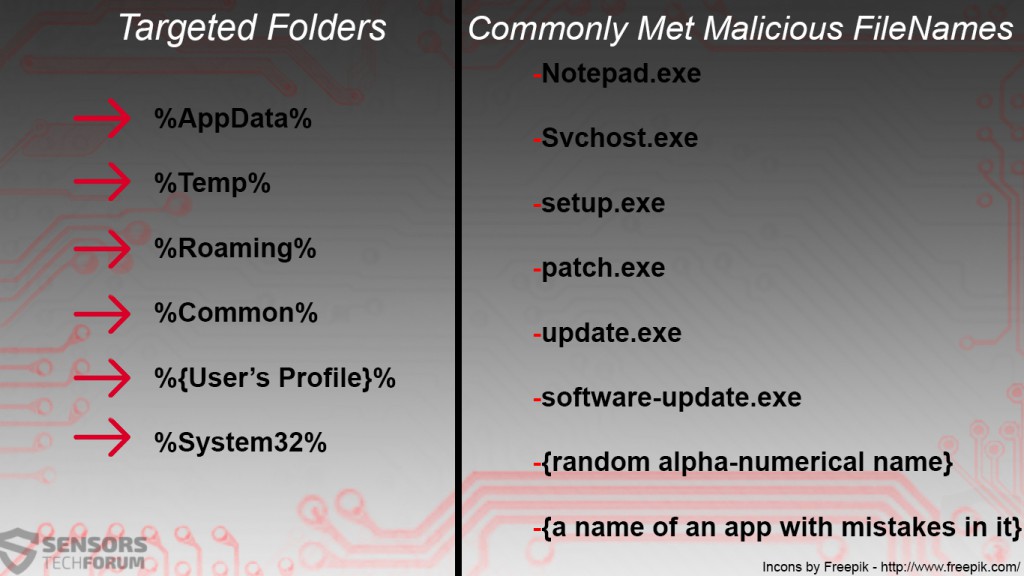 Ransowmare virus going by the name JackPot has been reported to slither undetected in user systems and encrypt their files using an encryption algorithm module after which change the wallpaper of the encrypted systems with a brief notification to pay 3.0 BTC which is approximately 800 US dollars. Researchers feel convinced that the virus is not very widespread but the bad news is that at it’s start it is undetected by any antivirus which means it may use good quality obfuscation tools. The victims are asked to make the ransom payoff in BitCoin and focus on immediately removing this seemingly low-quality virus from their computers and look for alternative methods to restore the encrypted files.
Ransowmare virus going by the name JackPot has been reported to slither undetected in user systems and encrypt their files using an encryption algorithm module after which change the wallpaper of the encrypted systems with a brief notification to pay 3.0 BTC which is approximately 800 US dollars. Researchers feel convinced that the virus is not very widespread but the bad news is that at it’s start it is undetected by any antivirus which means it may use good quality obfuscation tools. The victims are asked to make the ransom payoff in BitCoin and focus on immediately removing this seemingly low-quality virus from their computers and look for alternative methods to restore the encrypted files.
SensorsTechForum is actively investigating this cyber-threat and will soon update this article with more information.

Threat Summary
| Name |
JackPot |
| Type | Ransomware |
| Short Description | JackPot encrypts the files after infection and may modify the Windows Registry editor to change the wallpaper and notify the vicitm to pay 3.0 BTC ransom to get the encrypted files back. |
| Symptoms | The user may witness ransom notes and “instructions” which are set as wallpaper or text files on his computer. Widely used file types also become innaccessible and seem corrupted. |
| Distribution Method | Via an Exploit kit, Dll file attack, malicious JavaScript or a drive-by download of the malware itself in an obfuscated manner. |
| Detection Tool |
See If Your System Has Been Affected by malware
Download
Malware Removal Tool
|
| User Experience | Join our forum to Discuss JackPot Ransomware. |
| Data Recovery Tool | Windows Data Recovery by Stellar Phoenix Notice! This product scans your drive sectors to recover lost files and it may not recover 100% of the encrypted files, but only few of them, depending on the situation and whether or not you have reformatted your drive. |

JackPot Ransomware – How Is It Being Redistributed
In order for JackPot Ransomware to successfully cause an infection it has to be spammed properly. This is why, its developers may have undertaken massive spam e-mail campaigns in order to infect as many users as their abilities allow them to. The e-mail messages that are being sent by the cyber-crooks may resemble legitimate programs and services that could in fact be containing either malicious URLs that lead to websites or malicious e-mail attachments which only seem to be legitimate files, however do not even come close to such. Here is an example of a fake LinkedIn phishing e-mail that contains a malicious URL disguised as a button:

JackPot Ransomware – More Information
When unsuspecting users “hit the JackPot”, they often become clueless as to what happens behind the scenes. As soon as the infection is done, the JackPot ransomware may create different types of files that may exist under different names and be located in the usually targeted Windows folders:
After the files are situated, JackPot ransomware may either drop malicious files in the %Startup% directory or create custom registry entries in the Windows Registry Editor. Commonly targeted registry keys are the following:
HKEY_CURRENT_USER\Software\Microsoft\Windows\CurrentVersion\Run
HKEY_LOCAL_MACHINE\Software\Microsoft\Windows\CurrentVersion\RunOnce
HKEY_CURRENT_USER\Software\Microsoft\Windows\CurrentVersion\RunOnce
The JackPot ransomware may also engage in other activities such as delete the shadow volume copies by executing the vssadmin command in privileged Windows mode:
After having deleted all the bakcups, JackPot may employ encryption on the targeted files while remaining undetected. The virus may have been configured to encrypt several files partially or encipher all of the files at the same time besides crucial files for the functioning of Windows. The primary files that have the actual impact in terms of value for the user are:
- Videos.
- Images.
- Audio files.
- Database files.
- Adobe Reader PDF documents.
- Microsoft Office documents.
The encrypted files seem to be corrupted and can no longer be opened. A brief ransom note is left behind that aims to notify victims to pay the ransom:

Conclusion and Removal of JackPot Ransomware
JackPot ransomware is a virus that has made malware researchers to believe it is not a high quality ransomware and it’s infections are not expected to be massive in number. If you have been infected by this virus, however, researchers strongly recommend that you focus on removing it yourself and attempt to restore your files using the instructions we have suggested below.
- Step 1
- Step 2
- Step 3
- Step 4
- Step 5
Step 1: Scan for JackPot with SpyHunter Anti-Malware Tool



Ransomware Automatic Removal - Video Guide
Step 2: Uninstall JackPot and related malware from Windows
Here is a method in few easy steps that should be able to uninstall most programs. No matter if you are using Windows 10, 8, 7, Vista or XP, those steps will get the job done. Dragging the program or its folder to the recycle bin can be a very bad decision. If you do that, bits and pieces of the program are left behind, and that can lead to unstable work of your PC, errors with the file type associations and other unpleasant activities. The proper way to get a program off your computer is to Uninstall it. To do that:


 Follow the instructions above and you will successfully delete most unwanted and malicious programs.
Follow the instructions above and you will successfully delete most unwanted and malicious programs.
Step 3: Clean any registries, created by JackPot on your computer.
The usually targeted registries of Windows machines are the following:
- HKEY_LOCAL_MACHINE\Software\Microsoft\Windows\CurrentVersion\Run
- HKEY_CURRENT_USER\Software\Microsoft\Windows\CurrentVersion\Run
- HKEY_LOCAL_MACHINE\Software\Microsoft\Windows\CurrentVersion\RunOnce
- HKEY_CURRENT_USER\Software\Microsoft\Windows\CurrentVersion\RunOnce
You can access them by opening the Windows registry editor and deleting any values, created by JackPot there. This can happen by following the steps underneath:


 Tip: To find a virus-created value, you can right-click on it and click "Modify" to see which file it is set to run. If this is the virus file location, remove the value.
Tip: To find a virus-created value, you can right-click on it and click "Modify" to see which file it is set to run. If this is the virus file location, remove the value.
Before starting "Step 4", please boot back into Normal mode, in case you are currently in Safe Mode.
This will enable you to install and use SpyHunter 5 successfully.
Step 4: Boot Your PC In Safe Mode to isolate and remove JackPot





Step 5: Try to Restore Files Encrypted by JackPot.
Method 1: Use STOP Decrypter by Emsisoft.
Not all variants of this ransomware can be decrypted for free, but we have added the decryptor used by researchers that is often updated with the variants which become eventually decrypted. You can try and decrypt your files using the instructions below, but if they do not work, then unfortunately your variant of the ransomware virus is not decryptable.
Follow the instructions below to use the Emsisoft decrypter and decrypt your files for free. You can download the Emsisoft decryption tool linked here and then follow the steps provided below:
1 Right-click on the decrypter and click on Run as Administrator as shown below:

2. Agree with the license terms:

3. Click on "Add Folder" and then add the folders where you want files decrypted as shown underneath:

4. Click on "Decrypt" and wait for your files to be decoded.

Note: Credit for the decryptor goes to Emsisoft researchers who have made the breakthrough with this virus.
Method 2: Use data recovery software
Ransomware infections and JackPot aim to encrypt your files using an encryption algorithm which may be very difficult to decrypt. This is why we have suggested a data recovery method that may help you go around direct decryption and try to restore your files. Bear in mind that this method may not be 100% effective but may also help you a little or a lot in different situations.
Simply click on the link and on the website menus on the top, choose Data Recovery - Data Recovery Wizard for Windows or Mac (depending on your OS), and then download and run the tool.
JackPot-FAQ
What is JackPot Ransomware?
JackPot is a ransomware infection - the malicious software that enters your computer silently and blocks either access to the computer itself or encrypt your files.
Many ransomware viruses use sophisticated encryption algorithms to make your files inaccessible. The goal of ransomware infections is to demand that you pay a ransom payment to get access to your files back.
What Does JackPot Ransomware Do?
Ransomware in general is a malicious software that is designed to block access to your computer or files until a ransom is paid.
Ransomware viruses can also damage your system, corrupt data and delete files, resulting in the permanent loss of important files.
How Does JackPot Infect?
Via several ways.JackPot Ransomware infects computers by being sent via phishing emails, containing virus attachment. This attachment is usually masked as an important document, like an invoice, bank document or even a plane ticket and it looks very convincing to users.
Another way you may become a victim of JackPot is if you download a fake installer, crack or patch from a low reputation website or if you click on a virus link. Many users report getting a ransomware infection by downloading torrents.
How to Open .JackPot files?
You can't without a decryptor. At this point, the .JackPot files are encrypted. You can only open them once they are decrypted using a specific decryption key for the particular algorithm.
What to Do If a Decryptor Does Not Work?
Do not panic, and backup the files. If a decryptor did not decrypt your .JackPot files successfully, then do not despair, because this virus is still new.
Can I Restore ".JackPot" Files?
Yes, sometimes files can be restored. We have suggested several file recovery methods that could work if you want to restore .JackPot files.
These methods are in no way 100% guaranteed that you will be able to get your files back. But if you have a backup, your chances of success are much greater.
How To Get Rid of JackPot Virus?
The safest way and the most efficient one for the removal of this ransomware infection is the use a professional anti-malware program.
It will scan for and locate JackPot ransomware and then remove it without causing any additional harm to your important .JackPot files.
Can I Report Ransomware to Authorities?
In case your computer got infected with a ransomware infection, you can report it to the local Police departments. It can help authorities worldwide track and determine the perpetrators behind the virus that has infected your computer.
Below, we have prepared a list with government websites, where you can file a report in case you are a victim of a cybercrime:
Cyber-security authorities, responsible for handling ransomware attack reports in different regions all over the world:
Germany - Offizielles Portal der deutschen Polizei
United States - IC3 Internet Crime Complaint Centre
United Kingdom - Action Fraud Police
France - Ministère de l'Intérieur
Italy - Polizia Di Stato
Spain - Policía Nacional
Netherlands - Politie
Poland - Policja
Portugal - Polícia Judiciária
Greece - Cyber Crime Unit (Hellenic Police)
India - Mumbai Police - CyberCrime Investigation Cell
Australia - Australian High Tech Crime Center
Reports may be responded to in different timeframes, depending on your local authorities.
Can You Stop Ransomware from Encrypting Your Files?
Yes, you can prevent ransomware. The best way to do this is to ensure your computer system is updated with the latest security patches, use a reputable anti-malware program and firewall, backup your important files frequently, and avoid clicking on malicious links or downloading unknown files.
Can JackPot Ransomware Steal Your Data?
Yes, in most cases ransomware will steal your information. It is a form of malware that steals data from a user's computer, encrypts it, and then demands a ransom in order to decrypt it.
In many cases, the malware authors or attackers will threaten to delete the data or publish it online unless the ransom is paid.
Can Ransomware Infect WiFi?
Yes, ransomware can infect WiFi networks, as malicious actors can use it to gain control of the network, steal confidential data, and lock out users. If a ransomware attack is successful, it could lead to a loss of service and/or data, and in some cases, financial losses.
Should I Pay Ransomware?
No, you should not pay ransomware extortionists. Paying them only encourages criminals and does not guarantee that the files or data will be restored. The better approach is to have a secure backup of important data and be vigilant about security in the first place.
What Happens If I Don't Pay Ransom?
If you don't pay the ransom, the hackers may still have access to your computer, data, or files and may continue to threaten to expose or delete them, or even use them to commit cybercrimes. In some cases, they may even continue to demand additional ransom payments.
Can a Ransomware Attack Be Detected?
Yes, ransomware can be detected. Anti-malware software and other advanced security tools can detect ransomware and alert the user when it is present on a machine.
It is important to stay up-to-date on the latest security measures and to keep security software updated to ensure ransomware can be detected and prevented.
Do Ransomware Criminals Get Caught?
Yes, ransomware criminals do get caught. Law enforcement agencies, such as the FBI, Interpol and others have been successful in tracking down and prosecuting ransomware criminals in the US and other countries. As ransomware threats continue to increase, so does the enforcement activity.
About the JackPot Research
The content we publish on SensorsTechForum.com, this JackPot how-to removal guide included, is the outcome of extensive research, hard work and our team’s devotion to help you remove the specific malware and restore your encrypted files.
How did we conduct the research on this ransomware?
Our research is based on an independent investigation. We are in contact with independent security researchers, and as such, we receive daily updates on the latest malware and ransomware definitions.
Furthermore, the research behind the JackPot ransomware threat is backed with VirusTotal and the NoMoreRansom project.
To better understand the ransomware threat, please refer to the following articles which provide knowledgeable details.
As a site that has been dedicated to providing free removal instructions for ransomware and malware since 2014, SensorsTechForum’s recommendation is to only pay attention to trustworthy sources.
How to recognize trustworthy sources:
- Always check "About Us" web page.
- Profile of the content creator.
- Make sure that real people are behind the site and not fake names and profiles.
- Verify Facebook, LinkedIn and Twitter personal profiles.

















